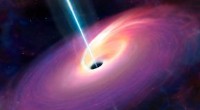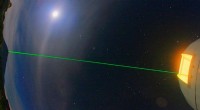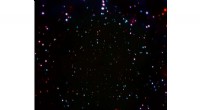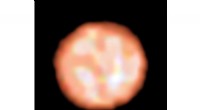
Wetenschap
Onderzoekers registreren succesvolle opstart van donkeremateriedetector in ondergrondse onderzoeksfaciliteit
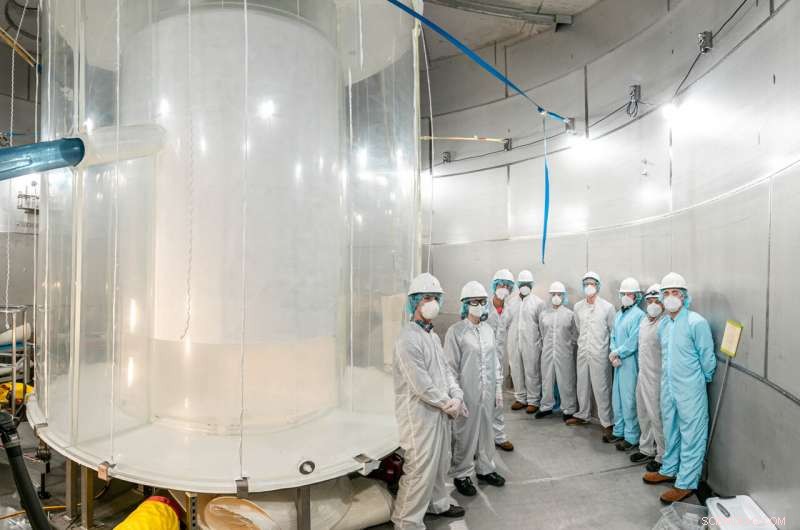
Leden van het LZ-team in de LZ-watertank na de installatie van de buitenste detector. Krediet:Matthew Kapust/Sanford ondergrondse onderzoeksfaciliteit
Diep onder de Black Hills van South Dakota in de Sanford Underground Research Facility (SURF), is een innovatieve en uniek gevoelige donkeremateriedetector - het LUX-ZEPLIN (LZ) -experiment, geleid door Lawrence Berkeley National Lab (Berkeley Lab) - geslaagd voor een check-out fase van opstartoperaties en leverde eerste resultaten op.
De boodschap van deze succesvolle startup:"We zijn er klaar voor en alles ziet er goed uit", zegt Berkeley Lab senior natuurkundige en voormalig LZ-woordvoerder Kevin Lesko. "Het is een complexe detector met veel onderdelen en ze werken allemaal goed binnen de verwachtingen", zei hij.
In een artikel dat vandaag online is geplaatst op de website van het experiment, melden LZ-onderzoekers dat LZ bij de eerste run al 's werelds meest gevoelige donkere-materiedetector is. De paper zal later vandaag in het online preprint-archief arXiv.org verschijnen. LZ-woordvoerder Hugh Lippincott van de University of California Santa Barbara zei:"We zijn van plan de komende jaren ongeveer 20 keer meer gegevens te verzamelen, dus we zijn nog maar net begonnen. Er is veel wetenschappelijk werk te doen en het is erg spannend."
Donkere materiedeeltjes zijn nooit echt gedetecteerd, maar misschien niet voor veel langer. Het aftellen is mogelijk begonnen met de resultaten van LZ's eerste 60 "live dagen" testen. Deze gegevens werden verzameld over een periode van drie en een halve maand van initiële operaties die eind december begonnen. Dit was een periode die lang genoeg was om te bevestigen dat alle aspecten van de detector goed functioneerden.
Ongezien, omdat het geen licht uitstraalt, absorbeert of verstrooit, zijn de aanwezigheid en aantrekkingskracht van donkere materie niettemin fundamenteel voor ons begrip van het universum. De aanwezigheid van donkere materie, naar schatting ongeveer 85 procent van de totale massa van het universum, bepaalt bijvoorbeeld de vorm en beweging van sterrenstelsels, en wordt door onderzoekers ingeroepen om uit te leggen wat er bekend is over de grootschalige structuur en expansie van het universum.
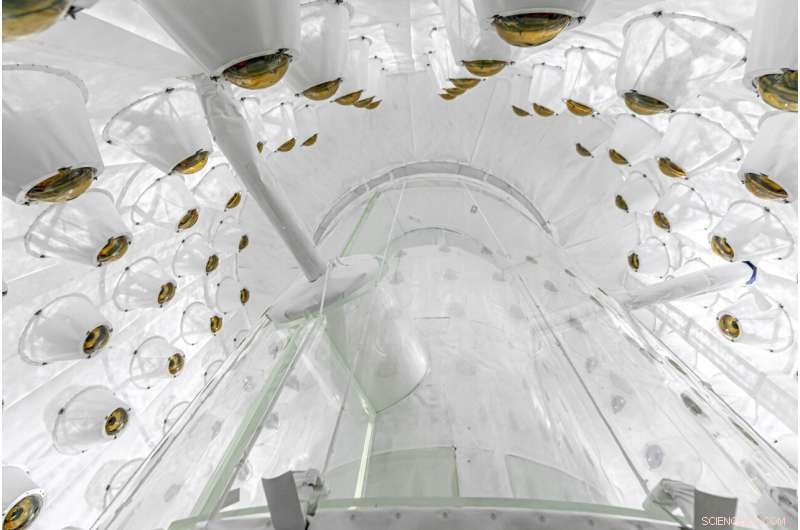
Omhoog kijken in de LZ Outer Detector, gebruikt om een veto uit te spreken over radioactiviteit die een signaal van donkere materie kan nabootsen. Krediet:Matthew Kapust/Sanford ondergrondse onderzoeksfaciliteit
Het hart van de LZ-detector voor donkere materie bestaat uit twee geneste titanium tanks gevuld met tien ton zeer zuivere vloeibare xenon en bekeken door twee arrays van fotomultiplicatorbuizen (PMT's) die zwakke lichtbronnen kunnen detecteren. The titanium tanks reside in a larger detector system to catch particles that might mimic a dark matter signal.
"I'm thrilled to see this complex detector ready to address the long-standing issue of what dark matter is made of," said Berkeley Lab Physics Division Director Nathalie Palanque-Delabrouille. "The LZ team now has in hand the most ambitious instrument to do so."
The design, manufacturing, and installation phases of the LZ detector were led by Berkeley Lab project director Gil Gilchriese in conjunction with an international team of 250 scientists and engineers from over 35 institutions from the US, UK, Portugal, and South Korea. The LZ operations manager is Berkeley Lab's Simon Fiorucci. Together, the collaboration is hoping to use the instrument to record the first direct evidence of dark matter, the so-called missing mass of the cosmos.
Henrique Araújo, from Imperial College London, leads the UK groups and previously the last phase of the UK-based ZEPLIN-III program. He worked very closely with the Berkeley team and other colleagues to integrate the international contributions. "We started out with two groups with different outlooks and ended up with a highly tuned orchestra working seamlessly together to deliver a great experiment," Araújo said.
An underground detector
Tucked away about a mile underground at SURF in Lead, S.D., LZ is designed to capture dark matter in the form of weakly interacting massive particles (WIMPs). The experiment is underground to protect it from cosmic radiation at the surface that could drown out dark matter signals.
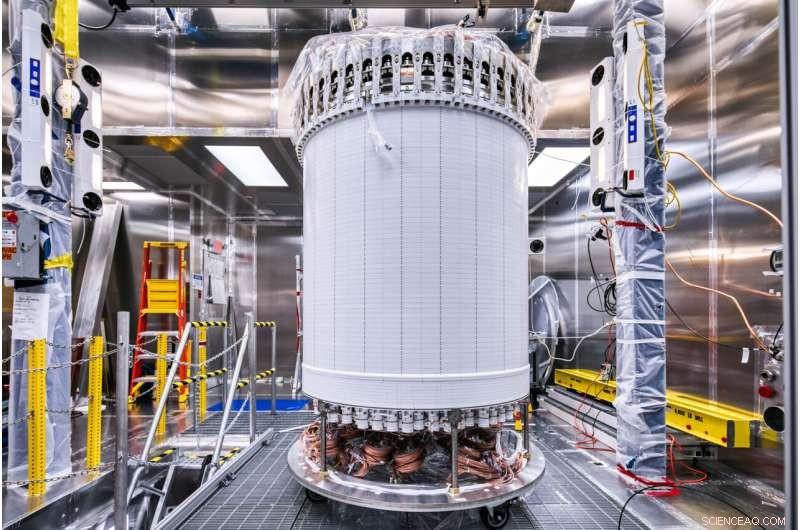
(Left) A schematic of the LZ detector. (Right) Illustration of LZ operation—particles interact in liquid xenon, releasing a flash of light and charge that are collected by photomultiplier tube arrays at top and bottom. Credit:Left schematic:LZ collaboration. Right image:LZ/SLAC
Particle collisions in the xenon produce visible scintillation or flashes of light, which are recorded by the PMTs, explained Aaron Manalaysay from Berkeley Lab, who as physics coordinator, led the collaboration's efforts to produce these first physics results. "The collaboration worked well together to calibrate and to understand the detector response," Manalaysay said. "Considering we just turned it on a few months ago and during COVID restrictions, it is impressive we have such significant results already."
The collisions will also knock electrons off xenon atoms, sending them to drift to the top of the chamber under an applied electric field where they produce another flash permitting spatial event reconstruction. The characteristics of the scintillation help determine the types of particles interacting in the xenon.
Mike Headley, executive director of SURF Lab, said, "The entire SURF team congratulates the LZ Collaboration in reaching this major milestone. The LZ team has been a wonderful partner and we're proud to host them at SURF."
Fiorucci said the onsite team deserves special praise at this startup milestone, given that the detector was transported underground late in 2019, just before the onset of the COVID-19 pandemic. He said with travel severely restricted, only a few LZ scientists could make the trip to help on site. The team in South Dakota took excellent care of LZ.
"I'd like to second the praise for the team at SURF and would also like to express gratitude to the large number of people who provided remote support throughout the construction, commissioning and operations of LZ, many of whom worked full time from their home institutions making sure the experiment would be a success and continue to do so now," said Tomasz Biesiadzinski of SLAC, the LZ detector operations manager.

The LZ central detector in the clean room at Sanford Underground Research Facility after assembly, before beginning its journey underground. Credit:Matthew Kapust, Sanford Underground Research Facility
"Lots of subsystems started to come together as we started taking data for detector commissioning, calibrations and science running. Turning on a new experiment is challenging, but we have a great LZ team that worked closely together to get us through the early stages of understanding our detector," said David Woodward from Pennsylvania State University, who coordinates the detector run planning.
Maria Elena Monzani of SLAC, the Deputy Operations Manager for Computing and Software, said, "We had amazing scientists and software developers throughout the collaboration, who tirelessly supported data movement, data processing, and simulations, allowing for a flawless commissioning of the detector. The support of NERSC [National Energy Research Scientific Computing Center] was invaluable."
With confirmation that LZ and its systems are operating successfully, Lesko said, it is time for full-scale observations to begin in hopes that a dark matter particle will collide with a xenon atom in the LZ detector very soon. + Verder verkennen
A major milestone for an underground dark matter search experiment
 Citrusderivaat maakt transparant hout 100 procent hernieuwbaar
Citrusderivaat maakt transparant hout 100 procent hernieuwbaar Nieuwe studie verklaart Mycobacterium tuberculosis hoge weerstand tegen medicijnen en immuniteit
Nieuwe studie verklaart Mycobacterium tuberculosis hoge weerstand tegen medicijnen en immuniteit Wetenschappers ontwikkelen Venus flytrap-biosensoren om verontreinigende stoffen te vangen
Wetenschappers ontwikkelen Venus flytrap-biosensoren om verontreinigende stoffen te vangen Nieuwe membraantechnologie om waterzuivering en energieopslag te stimuleren
Nieuwe membraantechnologie om waterzuivering en energieopslag te stimuleren Kunstmatige intelligentie helpt bij de fabricage van materialen
Kunstmatige intelligentie helpt bij de fabricage van materialen
 Ecologische ramp gevreesd terwijl Griekenland bosbrand bestrijdt
Ecologische ramp gevreesd terwijl Griekenland bosbrand bestrijdt Ontbossing met 57% gedaald in winterhabitat van Mexicaanse monarchvlinders
Ontbossing met 57% gedaald in winterhabitat van Mexicaanse monarchvlinders Brandstof wandelen en fietsen met koolstofarme diëten, onderzoekers zeggen:
Brandstof wandelen en fietsen met koolstofarme diëten, onderzoekers zeggen: Conservatieven zullen eerder klimaatbeleid steunen als ze schade melden als gevolg van extreem weer
Conservatieven zullen eerder klimaatbeleid steunen als ze schade melden als gevolg van extreem weer Overstroming verdrinkt St Marks onschatbare mozaïeken in riolering
Overstroming verdrinkt St Marks onschatbare mozaïeken in riolering
Hoofdlijnen
- Onderbroken herprogrammering zet volwassen cellen om in hoge opbrengsten van voorloperachtige cellen
- Greenpeace laat rotsblokken op de Britse zeebodem vallen om de bodemtrawlvisserij te beteugelen
- De soorten elektroforese
- Onderzoekers ontdekten dat overmatige sociale interactie de collectieve respons verminderde
- Hoe een celmodel te maken met Playdough
- Prehistorische vrouwen waren sterker dan de elite vrouwelijke atleten van vandaag
- Wat zijn de zes belangrijkste elementen in levende organismen?
- Uitbreiding van Braziliaans suikerriet kan de wereldwijde CO2-uitstoot verminderen
- Oudste ontdekking tot nu toe van fysogastrische insecten
 Hoe de Great Plains werden gevormd
Hoe de Great Plains werden gevormd Hoe werkt een waterkanon?
Hoe werkt een waterkanon?  Israëls eerste maanmissie ontploft vanuit Florida
Israëls eerste maanmissie ontploft vanuit Florida Hoe David wint van Goliath in de gevestigde industrie
Hoe David wint van Goliath in de gevestigde industrie In lijn:het eenvoudige ontwerp en de controle van MOF elektrische stroom
In lijn:het eenvoudige ontwerp en de controle van MOF elektrische stroom Afscheid nemen van slash-and-burn
Afscheid nemen van slash-and-burn Onderzoekers ontdekken dat zwakke chemische interacties een doos met oneindige mogelijkheden bij elkaar houden
Onderzoekers ontdekken dat zwakke chemische interacties een doos met oneindige mogelijkheden bij elkaar houden Ultrasnelle dynamiek van chirale spinstructuren waargenomen na optische excitatie
Ultrasnelle dynamiek van chirale spinstructuren waargenomen na optische excitatie
- Elektronica
- Biologie
- Zonsverduistering
- Wiskunde
- French | Italian | Spanish | Portuguese | Swedish | German | Dutch | Danish | Norway |

-
Wetenschap © https://nl.scienceaq.com


